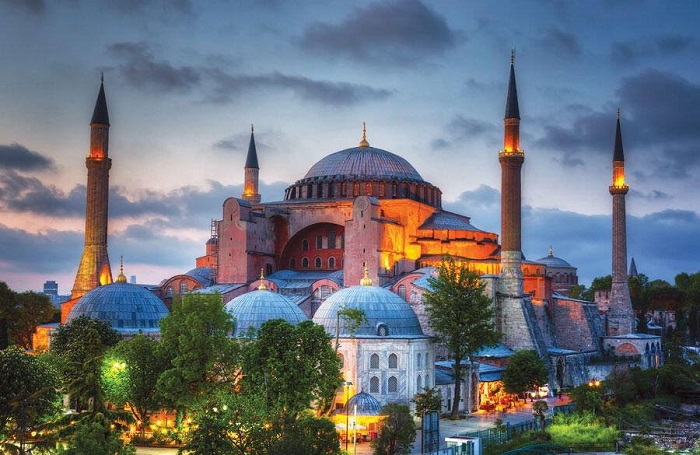Hagia Sophia: Enduring Monument Of Byzantine And Ottoman History

Table of Contents
The Byzantine Era: A Cathedral of Majestic Grandeur
The Hagia Sophia's story begins in the Byzantine Empire. Commissioned by Emperor Justinian I, its construction represents a pinnacle of Byzantine architectural achievement.
Architectural Marvels of the Byzantine Hagia Sophia:
The Hagia Sophia's architectural brilliance lies in its innovative dome, a feat of engineering unmatched for centuries.
- Immense Scale and Innovative Design: The dome's sheer size, spanning 107 feet in diameter, was groundbreaking for its time. Its weight was ingeniously distributed using pendentives, ingenious triangular supports that allowed the dome to rest on a square base, a remarkable solution to a complex architectural challenge.
- Materials and Craftsmanship: The construction employed high-quality materials, notably marble from across the Byzantine Empire, reflecting the empire's vast resources and power. Intricate mosaics and stunning marble columns further enhanced its beauty and grandeur.
- Master Architects: The design and construction were credited to the renowned architects Anthemius of Tralles and Isidore of Miletus, whose genius shaped the Hagia Sophia's unique form and enduring strength. The construction, which began in 532 AD and lasted around six years, involved thousands of workers and utilized cutting-edge techniques for that era.
Religious Significance and Iconography in Byzantine Hagia Sophia:
For almost a thousand years, the Hagia Sophia served as the seat of the Eastern Orthodox Church, a vital religious and political center of the Byzantine Empire.
- Center of Orthodox Christianity: Its religious significance was paramount, hosting important religious ceremonies, imperial coronations, and prayers. It symbolized the power and glory of the Byzantine emperors and the Church's authority.
- Theological Representations in Mosaics: The interior walls were adorned with exquisite mosaics, showcasing religious scenes and figures. These mosaics, many of which survive to this day, offer valuable insights into Byzantine art, theology, and imperial power. These surviving images are of exceptional artistic and historical value.
- Imperial Ceremonies and Rituals: The Hagia Sophia was the stage for magnificent imperial ceremonies, processions, and religious services, reinforcing the emperor's role as God's representative on Earth. These grand events shaped the cultural and political landscape of the empire.
The Ottoman Era: Transformation into a Mosque
The Ottoman conquest of Constantinople in 1453 marked a turning point in the Hagia Sophia's history.
The Conquest of Constantinople and the Hagia Sophia's Conversion:
The fall of Constantinople to Sultan Mehmed II brought an end to the Byzantine Empire and initiated a new chapter for the Hagia Sophia.
- The Ottoman Conquest: The conquest itself was a watershed moment in world history, shifting the balance of power in the region and marking the beginning of the Ottoman Empire's dominance.
- Conversion to a Mosque: Sultan Mehmed II, recognizing the Hagia Sophia's architectural magnificence, ordered its conversion into a mosque, adding minarets – the slender towers from which the call to prayer is issued – to its exterior. This conversion symbolized the shift in religious and political power.
- Ottoman Modifications: While respecting the original structure, the Ottomans made several modifications to adapt it for Islamic worship. The addition of the mihrab (a niche indicating the direction of Mecca) and the mimbar (the pulpit from which the imam delivers sermons) were significant changes.
Ottoman Artistic and Architectural Additions:
The Ottomans infused the Hagia Sophia with their own artistic and architectural styles, complementing rather than replacing the existing Byzantine elements.
- Calligraphy and Tilework: Intricate calligraphy and Iznik tiles, renowned for their vibrant colors and intricate patterns, were added to the interior, adding layers of Ottoman artistry to the existing Byzantine aesthetic.
- Preservation and Adaptation: The Ottomans, while transforming the Hagia Sophia for their religious needs, also took significant steps to preserve the building's integrity and maintain its magnificence, showing a respect for its previous history.
- Prominent Ottoman Architects: The modifications and maintenance throughout the Ottoman era involved several skilled architects and artisans, contributing to the building's ongoing transformation and preservation.
Modern Hagia Sophia: Museum and Ongoing Significance
The 20th century witnessed another significant transformation for the Hagia Sophia, its secularization, and its ongoing legacy as a global icon.
The Hagia Sophia as a Museum and its Secular Status:
In 1935, the Hagia Sophia was officially declared a museum by the Turkish government under Mustafa Kemal Atatürk, marking a shift from religious use to a secular role.
- UNESCO World Heritage Site: Recognized as a UNESCO World Heritage Site, the Hagia Sophia stands as a symbol of cultural heritage shared by multiple civilizations.
- Recent Controversies: Its recent reclassification as a mosque in 2020 and subsequent legal challenges highlights the ongoing debate surrounding the building's significance in modern Turkey and the world.
- Secular Symbolism: Its status as a museum underscores its broader significance as a unifying symbol of cultural and architectural heritage transcending religious divides.
Hagia Sophia's Enduring Legacy and Tourism:
The Hagia Sophia continues to inspire awe and wonder, its enduring influence impacting architecture, art, and tourism globally.
- Architectural Influence: Its architectural innovations have inspired countless buildings worldwide, demonstrating its lasting contribution to design and engineering. Its dome, in particular, remains an iconic architectural feature.
- Major Tourist Attraction: It attracts millions of visitors annually, generating substantial revenue and promoting Istanbul's cultural tourism. This demonstrates its enduring power to draw people from across the world.
- Ongoing Preservation: Continuous preservation efforts ensure the Hagia Sophia's survival for future generations, a testament to its international importance and the commitment to safeguarding its historical legacy.
Conclusion
From its Byzantine origins as a magnificent cathedral to its Ottoman transformation into a grand mosque and its current status as a museum, the Hagia Sophia's history is a tapestry woven from threads of faith, power, and artistic brilliance. Its enduring architectural marvels and iconic dome continue to inspire awe, while its rich mosaics and Ottoman additions provide glimpses into centuries of cultural exchange. The Hagia Sophia's ongoing significance as a UNESCO World Heritage site and a major tourist attraction reinforces its enduring legacy as a testament to human ingenuity and cultural exchange. Explore its rich history further – discover the wonders of the Hagia Sophia today!

Featured Posts
-
 Private Credit Jobs 5 Dos And Don Ts To Increase Your Chances Of Success
Apr 29, 2025
Private Credit Jobs 5 Dos And Don Ts To Increase Your Chances Of Success
Apr 29, 2025 -
 Riviera Blue Porsche 911 S T Exceptional Condition Now Available
Apr 29, 2025
Riviera Blue Porsche 911 S T Exceptional Condition Now Available
Apr 29, 2025 -
 Watch Lionel Messis Inter Miami Mls Matches Live Stream Schedule And Betting Odds
Apr 29, 2025
Watch Lionel Messis Inter Miami Mls Matches Live Stream Schedule And Betting Odds
Apr 29, 2025 -
 Capital Summertime Ball 2025 How To Buy Tickets Successfully
Apr 29, 2025
Capital Summertime Ball 2025 How To Buy Tickets Successfully
Apr 29, 2025 -
 Porsche 911 Wersja Za 1 33 Mln Zl Bije Rekordy Popularnosci W Polsce
Apr 29, 2025
Porsche 911 Wersja Za 1 33 Mln Zl Bije Rekordy Popularnosci W Polsce
Apr 29, 2025
